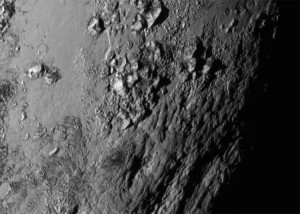Pluto Dazzles In First Close-Up
July 17, 2015
The first close-up images of the dwarf planet Pluto have dazzled planetary scientists, revealing a landscape more alien than they had imagined. Once thought to be a dead ball of rock and ice, Pluto turns out to be a world of giant mountains, mysteriously clean surfaces, and other wonders.

New close-up images of a region near Pluto’s equator reveal a giant surprise: a range of youthful mountains rising as high as 11,000 feet (3,400 meters) above the surface of the icy body.
Credit: NASA-JHUAPL-SwRI
The images were taken by the New Horizons probe, launched by the United States National Aeronautics and Space Administration (NASA). They were taken during the probe’s closest approach to Pluto on July 14, 2015, and they show features as small as ½ mile (0.8 kilometer) across. One image shows mountains rising up to 11,000 feet (3,400 meters) above the surrounding surface, comparable in height to the Rocky Mountains on Earth. These mountains appear to be made of water ice, because frozen methane and frozen nitrogen—two ices previously detected on Pluto’s surface—are too weak to form such steep structures. Observations from Earth had failed to detect any water ice on Pluto.
Scientists were also amazed by a relative lack of impact craters in the images. Such craters tend to build up over time as planets and other bodies are bombarded by chunks of rock and ice. The lack of craters suggests that the surfaces imaged are less than 100 million years old. Since Pluto is thought to be the same age as the rest of the solar system, about 4.5 billion years old, some process must be erasing craters, rejuvenating the planet’s surface. Weather and geological activity—such as earthquakes, volcanoes, and the shifting of tectonic plates—can erase impact craters. But both processes typically require more energy, in the form of heat, than the frigid planet of Pluto seems capable of producing.
It will take about 16 months for the New Horizons spacecraft to send back all the data it has gathered on its nearly 10-year mission. Until then, scientists will anxiously await clues to these and other mysteries.
Other World Book articles:
Astronomy (2006-a Back in time article)
Space exploration (2006-a Back in time article)


